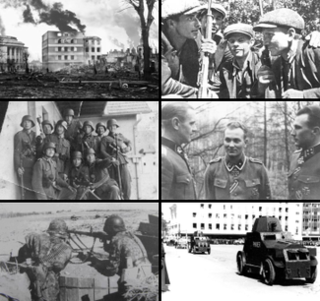Related Research Articles

The history of Estonia forms a part of the history of Europe. Humans settled in the region of Estonia near the end of the last glacial era, beginning from around 9000 BC. Starting with the Northern Crusades in the Middle Ages, Estonia became a battleground for centuries where Denmark, Germany, Russia, Sweden and Poland fought their many wars over controlling the important geographical position of the country as a gateway between East and West.

Narva is a municipality and city in Estonia. It is located in the Ida-Viru County, at the eastern extreme point of Estonia, on the west bank of the Narva river which forms the Estonia–Russia international border. With 53,626 inhabitants Narva is Estonia's third largest city after capital Tallinn and Tartu.

The Estonia men's national football team represents Estonia in international football matches and is controlled by the Estonian Football Association, the governing body for football in Estonia. Estonia's home ground is Lilleküla Stadium in the capital city Tallinn.

Novuss is a two-player game of physical skill which is closely related to carrom and pocket billiards. Novuss originates from Estonia and Latvia, where it is a national sport. The board is approximately 100 centimetres (39 in) square, typically made of wood, has pockets in each corner, and lines marked on the surface. The board is usually placed on a stand, but may be placed on a barrel or other surface that allows the pockets to hang down properly. It uses small discs instead of balls, and each player has a small puck instead of the cue ball used in other cue sports. Players use a small cue stick to propel their pucks into their colored object discs, knocking them into the pockets. The winner is the first one to sink all eight of their object discs.

In the course of Operation Barbarossa, Nazi Germany invaded Estonia in July–December 1941, and occupied the country until 1944. Estonia had gained independence in 1918 from the then-warring German and Russian Empires. However, in the wake of the August 1939 Nazi-Soviet Pact, the Soviet Union had invaded and occupied Estonia in June 1940, and the country was formally annexed into the USSR in August 1940.

Rugby union in Russia is a moderately popular sport. Russia was in 2011 ranked 20th worldwide by the World Rugby, having over three hundred clubs and close to 22,000 players nationally. Russian Rugby Championship is the top-level professional competition held in Russia. Krasnoyarsk, in the middle of Siberia, is traditionally the heartland of Russian rugby.

Rugby union in Georgia is a popular team sport. Rugby union is considered one of the most popular sports in Georgia.

Estonia–Russia relations are the bilateral foreign relations between Estonia and Russia. Diplomatic relations between the two countries were established on 2 February 1920 after the Estonian War of Independence ended in Estonian victory with Russia recognizing Estonia's sovereignty and renounced any and all territorial claims on Estonia.

Estonia declared neutrality at the outbreak of World War II (1939–1945), but the country was repeatedly contested, invaded and occupied, first by the Soviet Union in 1940, then by Nazi Germany in 1941, and ultimately reinvaded and reoccupied in 1944 by the Soviet Union.

Rugby union in Armenia is a growing sport. The national team is currently unranked in the world rankings, which records only the top ninety-six countries. The governing body for Armenia is the Rugby Federation of Armenia, headquartered in Yerevan.
The USSR national rugby union team represented the Soviet Union in rugby union until the early 1990s.
The Estonia national rugby union team is governed by the Estonian Rugby Union, which oversees all rugby union in Estonia. As of October 2014 they have played only a handful of matches, but have qualified for the 2014–16 European Nations Cup Third Division. The team's main stadium was Viimsi Staadion for several years.
Rugby union in Moldova is a popular sport. The governing body in Moldova is the Moldovan Rugby Federation.
Rugby union in Latvia is a minor but growing sport. During the pre-independence period, Latvia was not a centre for the game but nonetheless Latvia managed to qualify for the 1993 Rugby World Cup Sevens - which may be seen as the highest point it has yet reached.
Rugby union in Finland is a minor but growing sport. With both Men's and Women's 15's teams are represented in world rankings and both Women and Men's Sevens teams competing internationally.
Rugby union in Kazakhstan is a fairly popular sport. As of May 2018, they are ranked 61st by World Rugby, and as of June 2009, they had 2335 registered players and twenty clubs.

Rugby union in the Soviet Union was a moderately popular sport. It was most popular in the Georgian SSR; parts of the Russian SFSR such as Moscow and certain regions in Siberia like Krasnoyarsk; and Alma-Ata, the capital of the Kazakh SSR. Rugby enjoyed a more limited popularity in the Ukrainian SSR, Minsk in the Byelorussian SSR and parts of the RSFSR such as Leningrad and areas in Southern Russia, including Krasnodar. Rugby gained a significant following due to the vast size of the Soviet Union, but was never a major sport; despite many attempts to develop the sport, which Soviet citizens came to nickname the "leather melon" due to the shape of the ball. Still, an early championship in 1960 gives an idea of the sheer scale of Soviet rugby: one hundred teams from over thirty cities took part.
Rugby union in Belarus is a minor sport. They are currently affiliated to FIRA-AER.

The Estonian Soviet Socialist Republic, Soviet Estonia, or simply Estonia, was a union republic of the Soviet Union (USSR), covering the occupied and annexed territory of Estonia in 1940–1941 and 1944–1991. The Estonian SSR was nominally established to replace the until then independent Republic of Estonia on 21 July 1940, a month after the 16–17 June 1940 Soviet military invasion and occupation of the country during World War II. After the installation of a Stalinist government which, backed by the occupying Soviet Red Army, declared Estonia a Soviet constituency, the Estonian SSR was subsequently incorporated into the Soviet Union as a "union republic" on 6 August 1940. Estonia was occupied by Nazi Germany in 1941, and administered as a part of Reichskommissariat Ostland until it was reconquered by the USSR in 1944.
1990 Baltic League was an international football competition organized in 1990 between three Baltic states with the ongoing dissolution of the Soviet Union. The league consisting of 18 clubs from the Lithuania SSR, Estonian SSR, the Latvian SSR and a special invitee FC Progress Cherniakhovsk from Kaliningrad Oblast. For Lithuanian teams the league also served as a preliminary tournament for the first post-Soviet Lithuanian football championship.
References
- 1 2 3 4 "Rugby Union | Cash Advance | Debt Consolidation | Insurance | Free Credit Report at Heavensgame.com". www.heavensgame.com. Archived from the original on 2011-07-19.
- ↑ Rugby union in Russia and USSR (in Russian)
- ↑ "Ice Cricket - Tallinn Rugby Tours to Estonia". www.icecricket.co.uk.
- ↑ "Suomen Rugbyliitto - Miesten I-divisioona". www.finland.rugby. Retrieved 2024-02-21.